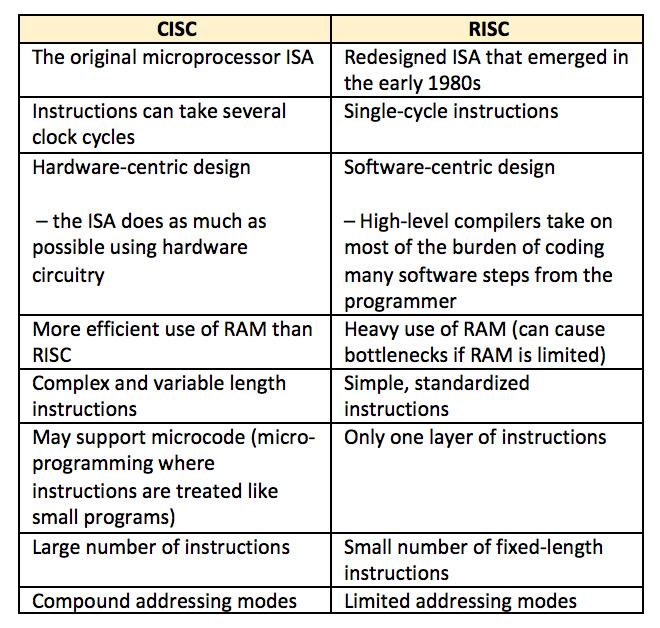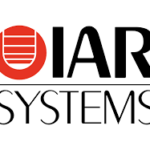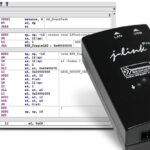Reduced Instruction Set Computer (RISC) is a type or category of the processor, or Instruction Set Architecture (ISA). Speaking broadly, an ISA is a medium whereby a processor communicates with the human programmer (although there are several other formally identified layers in between the processor and the programmer). An instruction is a command given to the processor to perform an action. An instruction set is the entire collection of instructions for a given processor, and the term architecture implies a particular way of building the system that makes the processor.
RISC generally refers to a streamlined version of its predecessor, the Complex Instruction Set Computer (CISC). At the dawn of processors, there was no formal identification known as CISC, but the term has since been coined to identify them as different from the RISC architecture. Some examples of CISC microprocessor instruction set architectures (ISAs) include the Motorola 68000 (68K), the DEC VAX, PDP-11, several generations of the Intel x86, and 8051.
Examples of processors with the RISC architecture include MIPS, PowerPC, Atmel’s AVR, the Microchip PIC processors, Arm processors, RISC-V, and all modern microprocessors have at least some elements of RISC. The progression from 8- and 16-bit to 32-bit architectures essentially forced the need for RISC architectures. Nevertheless, it took a decade before RISC architectures began to take hold, mainly due to lack of software that would run on RISC architectures. Intel also made an impact, since it had the means to continue using the CISC architecture and found no need to redesign from the ground up. The MIPS architecture was one of the first RISC ISAs and has been used widely to teach the RISC architecture.
Some history
The first integrated chip was designed in 1958 by Jack Kilby. Microprocessors were introduced in the 1970s, the first commercial one coming from Intel Corporation. By the early 1980s, the RISC architecture had been introduced. The RISC design came about as a total redesign because the CISC architecture was becoming more complex. Most credit John Cocke of IBM as having come up with the RISC concept. History tells us that to get a faster computer, some major changes in the microprocessor architecture took place that became RISC, including a uniform format for instructions and easily pipelined instructions. (Pipelining means the processor starts to execute the next instruction before the present instruction is completed.) In the 1970s, memory was costly, so smaller programs were a focus.
What are the differences between RISC and CISC?
The short answer is that RISC is perceived by many as an improvement over CISC. There is no best architecture since different architectures can simply be better in some scenarios but less ideal in others. RISC-based machines execute one instruction per clock cycle. CISC machines can have special instructions as well as instructions that take more than one cycle to execute. This means that the same instruction executed on a CISC architecture might take several instructions to execute on a RISC machine. The RISC architecture will need more working (RAM) memory than CISC to hold values as it loads each instruction, acts upon it, then loads the next one.
The CISC architecture can execute one, albeit more complex instruction, that does the same operations, all at once, directly upon memory. Thus, RISC architecture requires more RAM but always executes one instruction per clock cycle for predictable processing, which is good for pipelining. One of the major differences between RISC and CISC is that RISC emphasizes efficiency in cycles per instruction and CISC emphasizes efficiency in instructions per program. A fast processor is dependent upon how much time it takes to execute each clock cycle, how many cycles it takes to execute instructions, and the number of instructions there are in each program. RISC has an emphasis on larger program code sizes (due to a smaller instruction set, so multiple steps done in succession may equate to one step in CISC).
The RISC ISA emphasizes software over hardware. The RISC instruction set requires one to write more efficient software (e.g., compilers or code) with fewer instructions. CISC ISAs use more transistors in the hardware to implement more instructions and more complex instructions as well.
RISC needs more RAM, whereas CISC has an emphasis on smaller code size and uses less RAM overall than RISC. Many microprocessors today hold a mix of RISC- and CISC-like attributes, however, such as a CISC-like ISA that treats instructions as if they are a string of RISC-type instructions.
Some major differences between CISC and RISC architectures are listed in Table 1.







Well Written. Thankyou
I agree thoroughly! Great article to widen the public’s eyes on this technology war
Good read. Was a good refresher to RISC vs CISC
Very well written and informative!
Nice writeup
nice one
nice overview thanks to the autor!
Very useful content
Thanks